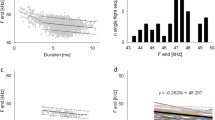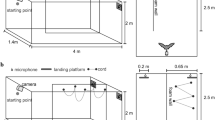Summary
The echolocation sounds of the hipposiderid batAsellia tridens consist of a constant frequency (cf) component followed by a frequency modulated (fm) terminal downward sweep of 19–21 kHz. The cf-part constitutes about 7/10 of the entire signal. In individual roosting animals the frequencies of the cf-part of consecutive sounds (resting frequency) is kept very constant but varies from bat to bat. In 18Asellia tridens resting frequencies between 111–124 kHz have been measured.
The sound duration in roosting and free flying bats is between 7–10 ms. In the approach and terminal phase of bats landing on a perch or flying through obstacles, the sound duration is reduced and the repetition rate increased the nearer the bat approaches the target. At the end of the terminal phase sound durations of a minimum of 3 ms have been measured. Flying bats lower their emission frequency in order to compensate for Doppler shifts caused by the flight movement. The echofrequency is therefore kept constant about 150–200 Hz above the resting frequency.
In flights through obstacles consisting of vertically stretched wires with different diameters, the bats were able to avoid wires down to a diameter of 0.065 mm whereas at 0.05 mm the percentage of flights without collisions is far below the chance level. The results demonstrate that the echolocation behavior of the hipposiderid batAsellia tridens does not differ fundamentally from that of rhinolophid bats. As a result, a new suggestion for categorization of bats producing cf-fm orientation sounds is put forward.
Similar content being viewed by others
Abbreviations
- cf :
-
constant frequency component
- fm :
-
frequency modulated component
- P :
-
probability of collision-free flights through an obstacle of ertically tretched wires
- I :
-
interval between wires
- D :
-
minimal diameter of a bat with folded wings; Θ, angle at which a bat approaches an obstacle
- f A :
-
frequency of the cf-component of the emitted sound
- f E :
-
frequency of the cf-component of the echo
- f M :
-
frequency of the cf-component of the sounds recorded with the microphone
- c :
-
speed of sound
References
Bateman, G.C., Vaughan, T.A.: Nightly activities of mormoopid bats. J. Mammal.55, 45–65 (1974)
Brosset, A.: La biologie des chiroptères. Paris: Masson et Cie. 1966
Flieger, E., Schnitzler, H.-U.: Ortungsleistungen der FledermausRhinolophus ferrumequinum bei ein- und beidseitiger Ohrverstopfung. J. Comp. Physiol.82, 93–102 (1973)
Goldman, L.J., Henson, O.W. Jr.: Prey recognition and selection by the constant frequency bat,Pteronotus p. parnellii. Behav. Ecol. Sociobiol.2, 411–419 (1977)
Griffin, D.R., Webster, F.A., Michael, C.R.: The echolocation of flying insects by bats. Anim. Behav.8, 141–154 (1960)
Grinnell, A.D., Hagiwara, S.: Adaption of the auditory nervous system for echolocation. Z. vergl. Physiol.76, 41–81 (1972)
Konstantinov, A.I., Sokolov, B.V.: Characteristics of ultrasonic orientation signals of horseshoe bat (Rhinolophidae). J. Evol. Biochem. Physiol.5, 90–97 (1969)
Möhres, F.P., Kulzer, E.: Ein neuer, kombinierter Typ der Ultraschallorientierung bei Fledermäusen. Naturwissenschaften42, 131–132 (1955)
Novick, A.: Orientation in paleotropical bats. I. Microchiroptera. J. Exp. Zool.138, 81–154 (1958)
Pye, J.D.: Bimodal distribution of constant frequencies in some hipposiderid bats (Mammalia: Hipposideridae). J. Zool. (Lond.)166, 323–335 (1972)
Pye, J.D.: Some preliminary observations on flexible echolocation systems. Proceedings of the fourth international bat research conference. Olembo, R.J. et al. (eds.), pp. 127–136. Kenya: Kenya Literature Bureau 1978
Pye, J.D., Roberts, L.H.: Ear movements in a hipposiderid bat. Nature225, 285–286 (1970)
Sales, G., Pye, J.D.: Ultrasonic communication by animals. London: Chapman and Hall 1974
Schnitzler, H.-U.: Discrimination of thin wires by flying Horsehoe bats (Rhinolophidae). In: Animal sonar system, Vol I. Busnel, R.G. (ed.), p. 68–87. Jouy-en-Josas: Laboratoire de Physiologie Acoustique 1967
Schnitzler, H.-U.: Die Ultraschall-Ortungslaute der Hufeisenfledermäuse (Chiroptera-Rhinolophidae) in verschiedenen Orientierungssituationen. Z. vergl. Physiol.57, 376–408 (1968)
Schnitzler, H.-U.: Echoortung bei der FledermausChilonycteris rubiginosa. Z. vergl. Physiol.68, 25–39 (1970a)
Schnitzler, H.-U.: Comparison of the echolocation behavior inRhinolophus ferrumequinum andChilonycteris rubiginosa. Bijdr. Dierk.40, 77–80 (1970 b)
Schnitzler, H.-U.: Control of Doppier shift compensation in the Greater Horseshoe Bat,Rhinolophus ferrumequinum. J. Comp. Physiol.82, 79–92 (1973 a)
Schnitzler, H.-U.: Die Echoortung der Fledermäuse und ihre hörphysiologischen Grundlagen. Fortschr. Zool.21, 136–189 (1973 b)
Schnitzler, H.-U.: Die Detektion von Bewegungen durch Echoortung bei Fledermäusen. Verh. Dtsch. Zool. Ges.1978, 16–33 (1978)
Schnitzler, H.-U., Flieger, E.: Detection of fluttering target movements by the echolocating cf-fm bat,Rhinolophus ferrumequimum. (In preparation)
Simmons, J.A., Howell, D.J., Suga, N.: Information content of bat sonar echos. Am. Sci.63, 204–215 (1975)
Author information
Authors and Affiliations
Additional information
Supported by the Deutsche Forschungsgemeinschaft grant no. Schn 138/6-9
We thank W. Hollerbach for technical assistance.
Rights and permissions
About this article
Cite this article
Gustafson, Y., Schnitzler, H.U. Echolocation and obstacle avoidance in the hipposiderid batAsellia tridens . J. Comp. Physiol. 131, 161–167 (1979). https://doi.org/10.1007/BF00619076
Accepted:
Issue Date:
DOI: https://doi.org/10.1007/BF00619076




